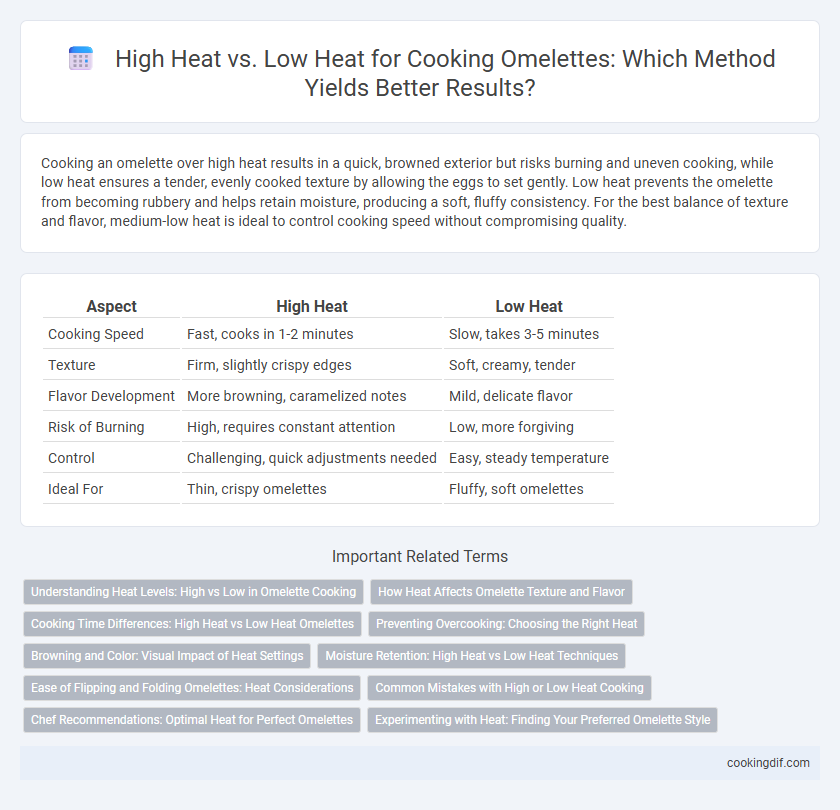Cooking an omelette over high heat results in a quick, browned exterior but risks burning and uneven cooking, while low heat ensures a tender, evenly cooked texture by allowing the eggs to set gently. Low heat prevents the omelette from becoming rubbery and helps retain moisture, producing a soft, fluffy consistency. For the best balance of texture and flavor, medium-low heat is ideal to control cooking speed without compromising quality.
Table of Comparison
| Aspect | High Heat | Low Heat |
|---|---|---|
| Cooking Speed | Fast, cooks in 1-2 minutes | Slow, takes 3-5 minutes |
| Texture | Firm, slightly crispy edges | Soft, creamy, tender |
| Flavor Development | More browning, caramelized notes | Mild, delicate flavor |
| Risk of Burning | High, requires constant attention | Low, more forgiving |
| Control | Challenging, quick adjustments needed | Easy, steady temperature |
| Ideal For | Thin, crispy omelettes | Fluffy, soft omelettes |
Understanding Heat Levels: High vs Low in Omelette Cooking
Cooking an omelette over high heat results in quick browning and a crisp exterior but risks uneven cooking and a rubbery texture. Low heat allows the eggs to cook gently and evenly, producing a tender, creamy omelette with a delicate texture and well-incorporated ingredients. Mastering the balance between high and low heat ensures a perfectly cooked omelette with optimal taste and consistency.
How Heat Affects Omelette Texture and Flavor
High heat creates a quick rise and browning on an omelette's surface, producing a slightly crispy texture and richer flavor due to the Maillard reaction. Low heat allows gentle cooking, ensuring a tender, creamy interior with a delicate taste, preventing browning and moisture loss. Adjusting heat optimizes omelette texture from fluffy to silky and enhances flavor development based on cooking time and temperature control.
Cooking Time Differences: High Heat vs Low Heat Omelettes
High heat omelettes cook quickly, often in just 1-2 minutes, resulting in a browned exterior but a risk of unevenly cooked or rubbery texture inside. Low heat omelettes take 3-5 minutes to cook, allowing for gentle heat distribution that produces a tender, evenly cooked, and creamy consistency. Adjusting cooking temperature directly impacts texture and doneness, making it essential to balance heat level according to desired omelette style.
Preventing Overcooking: Choosing the Right Heat
Cooking an omelette on low heat ensures even cooking and prevents the eggs from becoming rubbery or browned, preserving a tender, creamy texture. High heat causes rapid protein coagulation, increasing the risk of overcooking and toughening the omelette's surface. For optimal texture and moisture retention, maintaining moderate to low heat is essential in achieving a perfectly cooked omelette.
Browning and Color: Visual Impact of Heat Settings
Cooking an omelette over high heat accelerates browning, creating a golden crust with a visually appealing color that enhances texture. Low heat results in a paler, softer omelette with less Maillard reaction, preserving a creamy interior but reducing the visual contrast. Optimal heat control balances browning for aesthetic appeal and texture without burning or undercooking the eggs.
Moisture Retention: High Heat vs Low Heat Techniques
Using low heat to cook an omelette promotes better moisture retention, resulting in a tender and fluffy texture by allowing the eggs to cook evenly without drying out. High heat often causes rapid moisture loss, leading to a rubbery and dry omelette with uneven cooking. For optimal moisture retention and a delicate consistency, gentle heat control is essential.
Ease of Flipping and Folding Omelettes: Heat Considerations
Cooking omelettes over low heat ensures even cooking and makes folding easier without tearing, preserving the omelette's texture and appearance. High heat can cause rapid browning and a tougher surface, complicating flipping and folding due to quicker setting and potential sticking. Optimal heat control enhances maneuverability, resulting in a tender, pliable omelette that holds its shape during flipping and folding.
Common Mistakes with High or Low Heat Cooking
Cooking an omelette at high heat often results in uneven cooking, causing the exterior to burn while the interior remains undercooked or rubbery. Low heat cooking, on the other hand, may lead to a pale, dry omelette that lacks the desired fluffy texture. Achieving the perfect balance between temperature and timing prevents common mistakes such as overcooking or sticking, ensuring a tender, evenly cooked omelette.
Chef Recommendations: Optimal Heat for Perfect Omelettes
Chefs recommend cooking omelettes over medium to medium-low heat to ensure even cooking and a tender texture without browning or burning. High heat causes the eggs to cook too quickly, resulting in a rubbery or dry omelette with uneven texture. Optimal heat control allows the omelette to set gently, preserving moisture and enhancing flavor for a perfect, fluffy finish.
Experimenting with Heat: Finding Your Preferred Omelette Style
Cooking an omelette on high heat quickly sets the exterior, creating a crisp texture, while risking uneven cooking inside, whereas low heat allows gentle, even cooking, resulting in a tender, custard-like consistency. Experimenting with stove temperatures reveals how medium heat often balances both approaches, producing a fluffy omelette with slight browning. Chefs recommend adjusting heat based on omelette thickness and fillings to achieve the perfect texture and flavor profile.
High heat vs low heat for cooking Infographic

 cookingdif.com
cookingdif.com